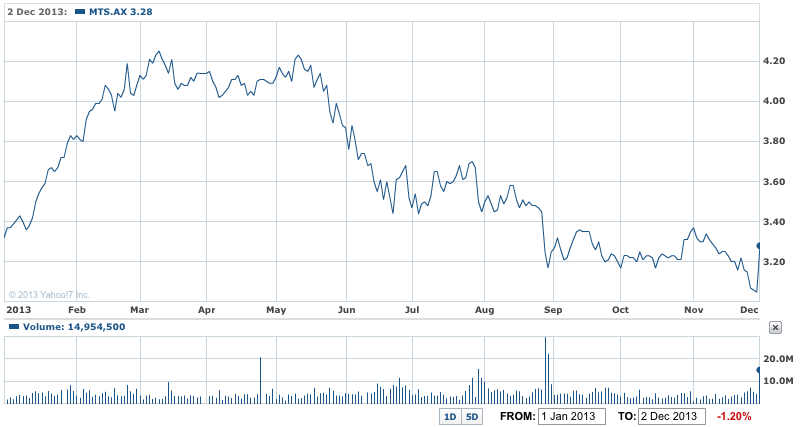Wholesaler/retailer Metcash (MTS), number 3 behind Woolies and Coles, faces more change in the New Year after reporting a moderate quality interim result yesterday and a cut to dividend.
That cut to dividend of more than 17% was made on top of a decision to restart the suspended dividend reinvestment program – a sure sign that Metcash is trying to restrict cash outflow.
On the face of it, the bottom line figures of a 20% lift in first half profit (thanks to its exit from the Franklins line of supermarkets) was a top result.
Metcash reported a net profit of $98.9 million for the six months to October 31, up from $82 million for the same time last year.
But underlying profit, which excludes one-offs like the costs of the exit from the Franklins business, was down 2% to $119 million.
That was on a 5% lift in group revenue from its grocery, liquor, hardware and automotive businesses to $6.65 billion, but pre-tax earnings fell more than 6% to $193 million, a result more in keeping with an earnings warning several months ago.
Directors attributed the fall to to several factors: "continuing price deflation which has exacerbated operating deleverage; greater investment in advertising and building marketing capability; and, intense competition – particularly the impact on independent retailers of excessive fuel discounts being offered by the self supply chains" .
But overall the market liked the Metcash figures and its commentary – the shares rose 7.5% to $3.28 on a day when the wider market was whacked by sharp falls, led by the big banks. For that reason the reaction to the Metcash result was encouraging. The rise was the biggest among the few in the ASX 200 stocks yesterday.
MTS YTD – Metcash shares up on hope and despite a weak interim result

Interim dividend was cut to 9.5c a share, from 11.5c a share for the first half of 2012-13.
The company said the lowered payout was on top of the 5% expansion in the number of shares on issue as a result of an earlier fund raising.
It argued that the result was a payout ratio of around 70%, which was still in the region of the commitment to repay 60% plus of profits to shareholders.
But a look at the company’s profit presentation and analysis filed with the ASX shows the payout ratio for the six months to October 31 was the lowest interim payout ratio for five years, a sign the company is trying to curb cash outflow.
The restarted dividend reinvestment program for the interim dividend will offer a hardly generous discount of 1% to the average prevailing market price.
But it is a sign the company wants to keep as much cash as possible ahead of revealing the results of an almost finished strategic review.
"The Strategic Review is largely complete for all divisions of the Group with clear overall conclusions. There remains more work to complete the detail within the plans and ensure there is alignment with all key stakeholders.
"A more detailed outline of the strategy will be presented at an Investor Strategy Day in March 2014," the company told the market yesterday.
Looking to the next year, directors made it clear they saw a continuation of the sluggish conditions and intense competition from its larger rivals.
"Trading conditions in food and grocery will continue to remain challenging. Metcash has developed a clear plan to adapt the food and grocery business to the increasingly competitive deflationary environment.
"Whilst it will take time to restore food and grocery to sustainable growth, Metcash remains confident that the strategic plan will better leverage the underlying strength of the independent channel. The liquor, hardware and auto pillars remain well positioned for growth," the company said.
The company said it is looking for earnings to grow in "the high single digits".
Metcash group chief executive Ian Morrice said the company, which provides to IGA and Foodworks supermarkets, was continuing to suffer with tough market conditions and food price deflation.
He said it was difficult for the company to compete against supermarket giants Woolworths and Coles, who he said distorted the market through cross-subsidisation between their grocery and fuel businesses.













